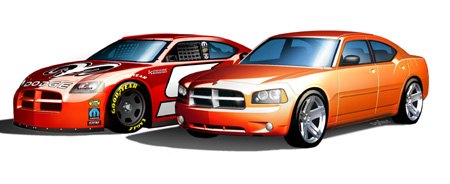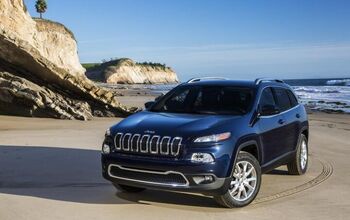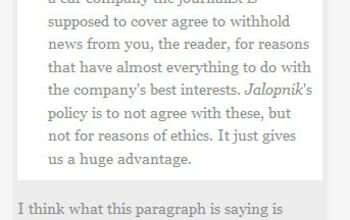Embargo This!
Before you read this editorial, you must first agree not to show it to anyone until next Tuesday. Yeah, right. And yet carmakers routinely provide new product news and photographs to the press subject to a mutually agreed release date. The industry calls the practice a "news embargo". It's the dirty little secret that lies at the heart of the relationship between automakers and the press.
It's easy to understand why automakers love a good embargo: a carefully-timed news blackout is the key to coordinating a vehicle's public debut– from tease to reveal to nationwide campaign. If the general public hears about a new car too early, the thrill of the new strangles the sales of the old. If an upcoming product's particulars arrive too late, valuable marketing momentum is lost. The news embargo significantly decreases the automakers' risk of blowing their big bucks product launches.
By their very nature, the news embargo also limits negative buzz. Think of it this way: if loose lips sink ships, an embargo can help keep a leaky ship afloat. Equally important, the blackout extends to "third parties", so the press can't reveal new model information to outside experts. When the embargo ends and the story breaks, the public receives only the manufacturer's details/photographs (along with a bit of editorially neutral background). Later, well, who cares? The damage has not been done.
Compare the early coverage given the new Dodge Charger with later, less widespread reports chronicling muscle car aficionados' outrage at the new Charger's four-door design. By sitting on Dodge's concept sketches as instructed, the automotive press helped guarantee a positive result for DCX, and a negative one for Charger purists.
Members of the motoring media perpetuate the embargo system because they figure if they don't play ball, they'll be locked out of the ballpark. This justification was brought into sharp focus last December. When embargoed pictures of the new Corvette Z06 suddenly appeared on-line, GM dispatched two Securitas goons to threaten an offending webmaster. Autoweek reported on the intimidation, ran the 'Vette pic, and clarified their position on news embargos: "We won't be the first to break an embargo, but neither will we be the last".
Of course, Autoweek and their ilk realize that the web threatens the status quo– even if dozens of websites responded to GM's threats by pulling the Z06 pictures off-line. While the mainstream automotive press is not about to tell carmakers to stick their news embargos up their figurative tail pipes, they're more than happy to let the newbies chip away at the system. Rest assured: if the new electronic media can get away with embargo running, the old guard will be right behind them; ready, willing and able to capitalize on their competitors' bravery.
Fortunately, the news embargo is under attack from other quarters. These days, scoop hunters like Brenda Priddy and John Johnson prowl the Las Vegas desert and German Nürburgring, capturing photos of future models. The publication of these spy shots, and the increasing use of Photoshop to generate computer models based the images, are positive signs that the automotive PR guys no longer call all the shots. But the corporate communicators are nothing if not resilient. They've responded to the sneak attacks with an advanced embargo technique called the "private press preview".
For example, a few months ago Saturn presented its upcoming models to selected automotive writers. Journalists emerged from the hush-hush happening suitably enthused about the company's new design and engineering direction. But an embargo left the hacks unable to talk about Saturn's future products in any detail– aside from the "happy days are here again" party line.
Although Saturn PR sold the embargoed event as background, it was clearly designed to stem the flood of criticism directed at GM's faltering division. And it worked; the debate about Saturn's tired product range has gone quiet. This despite the fact that there's no guarantee that the previewed cars will make it into production, or that they'll be any good if they do.
Of course, the news embargo only persists because it's a win – win situation for the players involved. The manufacturers get to manipulate the news, while the press knows they'll never be out of the loop. Equally important, by keeping more aggressive journalists away from the master's table, embargos perpetuate and maintain the power of the buff book boys' club.
The only real loser is the general public. News embargos restrict the free flow of timely, unbiased information. They also muddy the journalistic waters, denying interested enthusiasts a vigorously independent automotive press. To rectify the situation, all automotive publications should refuse to agree to any news embargo, no matter how tempting such 'scoop insurance' may be. It's our policy, and it should be theirs.
More by Robert Farago
Latest Car Reviews
Read moreLatest Product Reviews
Read moreRecent Comments
- Yuda I'd love to see what Hennessy does with this one GAWD
- Lorenzo I just noticed the 1954 Ford Customline V8 has the same exterior dimensions, but better legroom, shoulder room, hip room, a V8 engine, and a trunk lid. It sold, with Fordomatic, for $21,500, inflation adjusted.
- Lorenzo They won't be sold just in Beverly Hills - there's a Nieman-Marcus in nearly every big city. When they're finally junked, the transfer case will be first to be salvaged, since it'll be unused.
- Ltcmgm78 Just what we need to do: add more EVs that require a charging station! We own a Volt. We charge at home. We bought the Volt off-lease. We're retired and can do all our daily errands without burning any gasoline. For us this works, but we no longer have a work commute.
- Michael S6 Given the choice between the Hornet R/T and the Alfa, I'd pick an Uber.





































Comments
Join the conversation